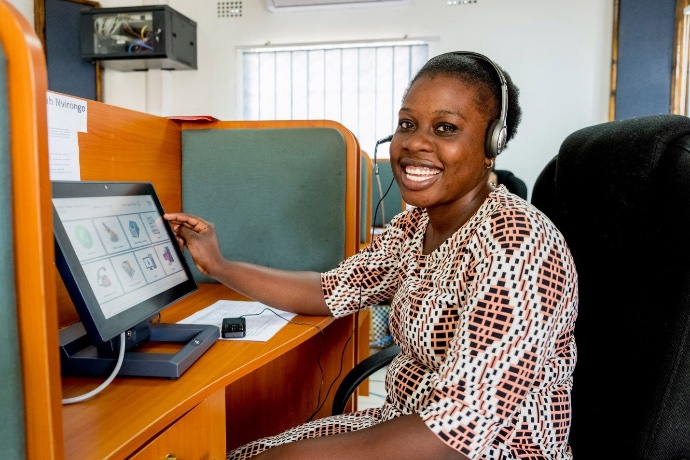By Jessica Mayenda, VillageReach

Call Center Attendant Florence Banda in the National Call Center, Lilongwe, Malawi. Photo credit: Paul Joseph Brown
In many parts of Africa, accessing quality health care has long been a daunting challenge, especially for those in remote or hard-to-reach areas. Yet, a technological transformation is underway, reshaping this narrative.
Meet Tiwonge, a vibrant mother of three from rural Malawi, navigating the complexities of health care while living miles away from the nearest clinic. Her story mirrors that of countless others across the continent who are now witnessing the transformative power of AI-driven telehealth.
Through innovative tools like AI-powered chatbots and teleconsultations, barriers to care are being reduced, providing timely support and empowering individuals to take charge of their health. This shift is not only improving lives locally but also setting the stage for global impact in health care delivery.
Increased Access for Mothers Across Africa
In rural Malawi, Tiwonge faces daily hurdles. With the nearest health facility over five kilometers away, each antenatal visit requires significant sacrifices—from transport costs to time away from home.
Now, picture an alternative: Tiwonge receives a text in her local language reminding her of her check-up and offering a simple self-assessment tool. With guidance from an AI-powered chatbot, she can decide whether a visit to the clinic is necessary or if her concerns can be managed remotely through teleconsultation. This timely support not only eases her worries but also saves valuable resources.
A similar transformative story unfolds in northern Nigeria, where a mother uses her basic mobile phone to dial a toll-free number. She instantly connects with a trained community nurse, receiving tailored advice and guidance to essential local services—all through a simple telehealth system. These narratives illustrate telehealth’s potential to bridge gaps in health care delivery, ensuring that every mother, regardless of location, can access quality care.
Strengthening Health Workers and Health Systems
For frontline health workers, AI-driven telehealth can offer much more than remote consultations. It can equip them with:
- Real-Time Updates: Continuous training and updates on treatment guidelines.
- Diagnostic Support: Advanced decision-support tools that improve diagnostic accuracy.
- Administrative Relief: Automation of routine tasks, such as report filing and patient data tracking, allows for more time dedicated to compassionate care.
Telehealth not only enhances individual patient care but also enables governments to make informed, strategic decisions. By analyzing data from telehealth platforms, health systems can pinpoint resource gaps, forecast potential complications and ensure that even remote clinics are well-equipped with essential medicines and equipment.
Scaling Telehealth through a Global Community of Practice
While these innovations are proving transformative at the local level, scaling telehealth to reach its full potential requires a global collaborative effort. The Global Telehealth Community of Practice (GTCoP) was launched to unite governments, NGOs, funders and technology partners. Their mission is clear: break down barriers, share best practices and drive systemic change. GTCoP’s network facilitates:
- Shared Learning: Through an interactive platform, stakeholders exchange case studies, technical insights and policy recommendations.
- Collaborative Policy Making: Experts work together to create adaptable frameworks and standards that cater to diverse local contexts.
- Capacity Building: Targeted training initiatives enhance digital literacy, ensuring that health workers are equipped to handle the ever-evolving telehealth tools.
The GTCoP initiative underscores that telehealth’s success depends on collective action—bridging divides and harmonizing efforts across geographies to create robust, sustainable systems.
Overcoming Barriers to Ensure Inclusivity
Despite the promise of telehealth, significant challenges remain, including:
- Policy Gaps and Infrastructure: Many countries lack comprehensive policies and necessary infrastructure—such as reliable electrical power and consistent telecommunications—to support widespread telehealth adoption.
- Digital Literacy and Trust: Both patients and health workers sometimes struggle with adapting to new technologies. Building trust through education and designing solutions that work on basic phones or offline can bridge this gap.
- Fragmented Knowledge: Too often, innovations occur in silos. By fostering global networks like GTCoP, stakeholders can share tools, experiences, and strategies to collaboratively overcome these challenges.
Addressing these barriers is essential to ensure that the benefits of AI-driven telehealth are accessible to all communities, regardless of their socio-economic or geographical circumstances.
A Vision for the Future
Imagine a future where Tiwonge and millions of others never have to choose between their well-being and their children’s health. A world where every mother can receive timely, personalized care and every health worker is equipped with the latest tools and knowledge. This vision is already taking shape through the combined efforts of local innovations, organizations like VillageReach and global networks like the GTCoP.
Together, these initiatives are redefining health care delivery, ensuring that quality care becomes a universal reality rather than a privilege for a few.
With contributions from Edwin Mulwa, Director and Team Lead, Digital Solutions GTT, VillageReach. For more information about these transformative projects, get in touch with Jessica at jessica.mayenda@villagereach.org.